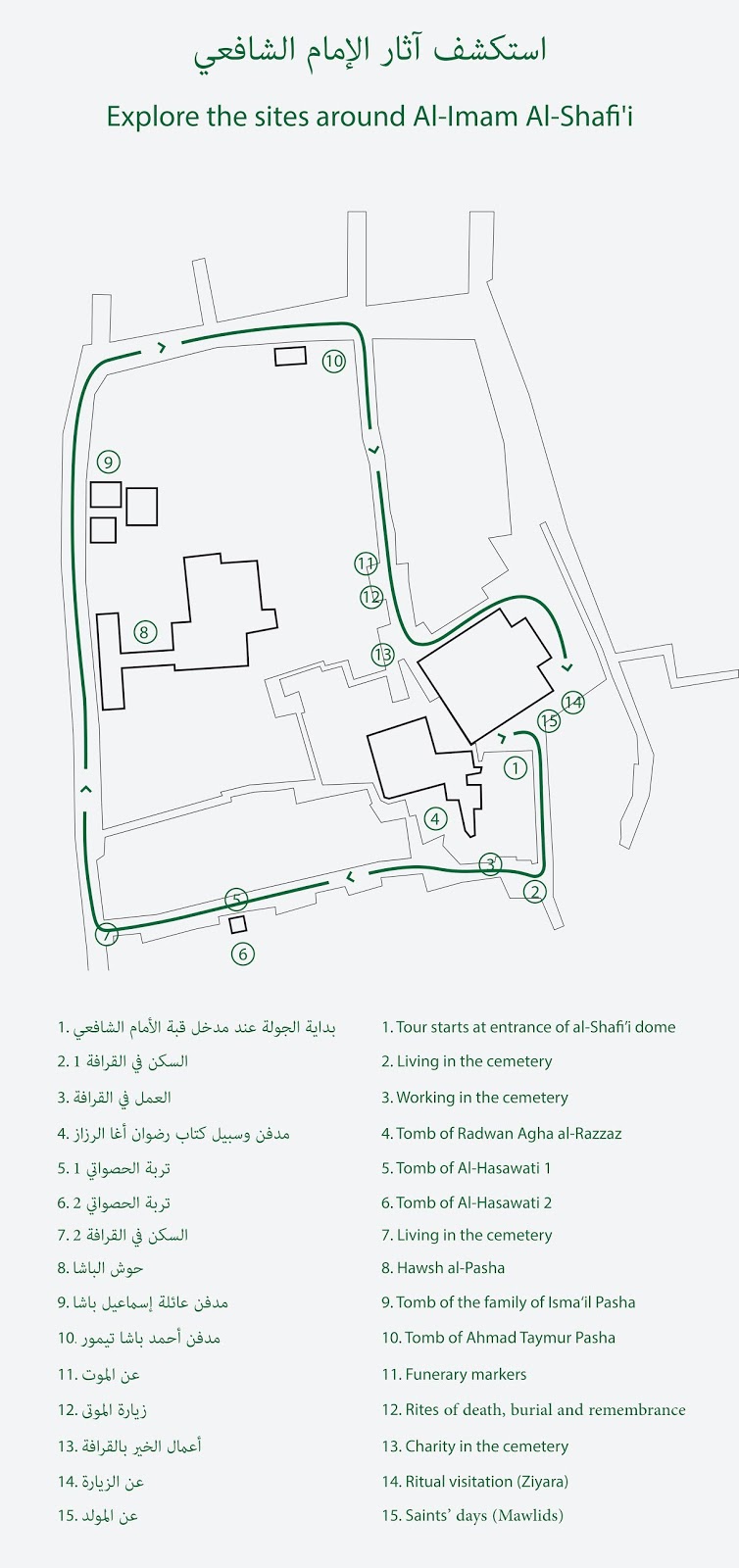الأعمال الخيرية بالقرافة / Charity in the cemetery
عن أبي هريرة رضي الله عنه أن رسول الله ﷺ قال: إذا مات ابن آدم انقطع عمله إلا من ثلاث: صدقة جارية، أو علم ينتفع به، أو ولد صالح يدعو له.
لهذا الحديث دلالة خاصة هنا. الكثير مما تم تشييده حول القبور كان بهدف اكتساب الحسنات بعد الموت. فالمدارس والخانقاوات والكتاتيب جميعها مؤسسات تنتج العلم وتدرًسه ونشاطات مثل تلاوة القرآن والذكر والدعاء والأوراد يمكن اعتبارها شكل من أشكال الدعاء للميت. بل لجأ البعض إلى تشييد مقابرهم على قارعة الطريق للاستفادة من دعاء المارة. وتضمن الأوقاف استمرارية هذه النشاطات وصيانة المنشآت. وذلك بالإضافة إلى جهات صرف بالوقفية لأعمال خيرية مثل توزيع الطعام والخيرات.
وتعتبر أعمال توفير الماء من أهم النشاطات وذلك لندرة الماء بالقرافة. فقام الأعيان ببناء مجاري العيون والإسبلة الملحق بها الصهاريج تحت الأرض. جهات الصرف بالوقفيات لتوزيع الماء بالقرافة ليست فقط للشرب أو الوضوء والاغتسال – أيضًا لرش الماء على القبور على والريحان والخوص الملقاة أعلاها، وجميعها من طقوس الزيارة. وتختلف أشكال الأسبلة – فهناك المباني التي تعلوها الكتاتيب والحنفيات البسيطة على واجهات المباني. كذلك طرق نقل المياه من السقا إلى مجرى العيون إلى مواسير المياه تحت الأرض. فنجد مثلاً أن السلطان الأيوبي الكامل محمد شيّد مجرى عيون لتوفير هذه المنطقة بالماء وكذلك محمد علي باشا الذي قام ببناء آخر مجرى عيون عام 1838 تم استبداله بعد فترة وجيزة بمواسير مياه.
لهذا الحديث دلالة خاصة هنا. الكثير مما تم تشييده حول القبور كان بهدف اكتساب الحسنات بعد الموت. فالمدارس والخانقاوات والكتاتيب جميعها مؤسسات تنتج العلم وتدرًسه ونشاطات مثل تلاوة القرآن والذكر والدعاء والأوراد يمكن اعتبارها شكل من أشكال الدعاء للميت. بل لجأ البعض إلى تشييد مقابرهم على قارعة الطريق للاستفادة من دعاء المارة. وتضمن الأوقاف استمرارية هذه النشاطات وصيانة المنشآت. وذلك بالإضافة إلى جهات صرف بالوقفية لأعمال خيرية مثل توزيع الطعام والخيرات.
وتعتبر أعمال توفير الماء من أهم النشاطات وذلك لندرة الماء بالقرافة. فقام الأعيان ببناء مجاري العيون والإسبلة الملحق بها الصهاريج تحت الأرض. جهات الصرف بالوقفيات لتوزيع الماء بالقرافة ليست فقط للشرب أو الوضوء والاغتسال – أيضًا لرش الماء على القبور على والريحان والخوص الملقاة أعلاها، وجميعها من طقوس الزيارة. وتختلف أشكال الأسبلة – فهناك المباني التي تعلوها الكتاتيب والحنفيات البسيطة على واجهات المباني. كذلك طرق نقل المياه من السقا إلى مجرى العيون إلى مواسير المياه تحت الأرض. فنجد مثلاً أن السلطان الأيوبي الكامل محمد شيّد مجرى عيون لتوفير هذه المنطقة بالماء وكذلك محمد علي باشا الذي قام ببناء آخر مجرى عيون عام 1838 تم استبداله بعد فترة وجيزة بمواسير مياه.
The loose translation of this saying of the Prophet is as follows: When human beings die, the deeds that count towards the afterlife stop except for three; continuous charity (sadaqa jarirya), useful knowledge (‘ilm nafi’) and virtuous sons or daughters who pray for them (walad salih).
This is of particular significance to the cemetery because it shapes much of what is built and what happens in it. Institutions of religious education (religious colleges, sufi hospices and Quran schools for orphans) are all generators of knowledge and structures marking graves with Quran recitation, religious poetry and supplications echoing through them are - in a way - prayers for mercy for those buried there. Some went as far as making sure their tombs were on a main street to guarantee as much du’a’ or supplication as possible. All of this is maintained through endowments – funds in perpetuity that maintain the cemetery buildings and their activities in addition to financing other forms of charity such as the distribution of food. Water is of particular significance because it is a scarce commodity in the cemetery. The rich and the powerful constructed aqueducts, dug cisterns with sabils above them for the charitable dispensation of water. Endowments included allocations for the procurement and distribution of water that is not just used for drinking or ablution. During visitation it is traditional to spray water on graves and use it to keep the basil and palm frond laid on graves fresh. Water was transferred to the cemetery in different ways, from small amounts of water carried by water carriers in jars or huge leather pouches, to impressive aqueducts such as that built by the Ayyubid Sultan al-Kamil to provide this entire area with water. The latest one, built much later by Muhammad ‘Ali Pasha in 1838, was replaced by underground pipes only 33 years after.

